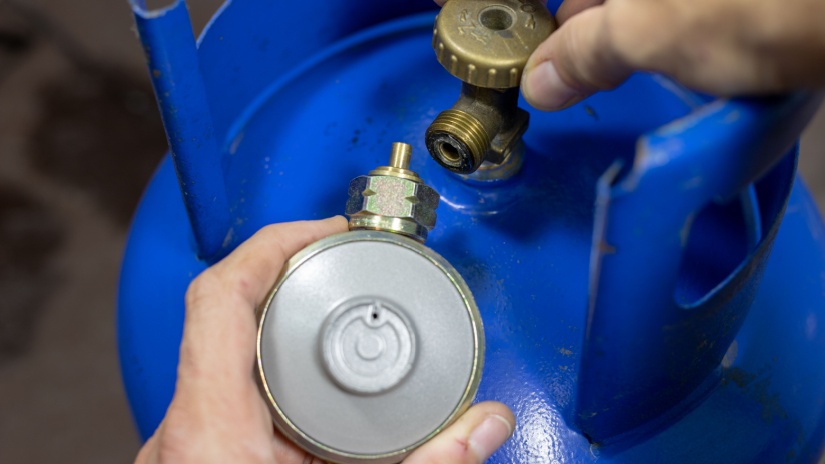Knowledge Centre
What is an LPG gas regulator?

Thinking about installing a gas barbecue this summer or using a gas cylinder for outdoor cooking? In Australia, where outdoor grilling is popular, gas bottles are a common sight. If so, you might need to invest in an LPG regulator.
However, many people are less familiar with the components of an LPG system, such as gas regulators. Let’s explore why gas regulators are crucial for safely managing your gas supply.
What is LPG?
We’ve talked through LPG before in this previous article, but let’s refresh it anyway. LPG, or liquefied petroleum gas, is a blend of propane and butane. These gases are mixed to create LPG, but they can also be bought separately.
Butane, with a boiling point of -2ºC, is commonly used for camping, small cooking devices, and indoor heaters. Propane, which boils at -42ºC, is more versatile and suitable for year-round use. It’s typically used for heating and powering larger appliances like barbecues.
An LPG regulator ensures the right amount of gas and pressure is delivered from the tank. For example, when you’re grilling, the regulator helps control the propane flow and temperature, making your barbecue experience smoother.
In most parts of Australia, LPG cylinders contain only propane. However, in Western Australia, LPG might be either pure propane or a 50/50 mix of propane and butane.
Why you might need an LPG regulator
An LPG regulator controls the flow and pressure of gas from the tank to your appliances. It ensures that the propane gas is delivered at the right temperature and pressure for safe and efficient cooking.
LPG is stored in pressurised containers to keep it in liquid form. This makes it more compact—liquefied propane and butane are about 250 times smaller in volume than their gaseous form.
The regulator controls the pressure as the liquid turns into gas, ensuring safety. It prevents too much or too little gas from being released, which could be dangerous.
What does the regulator do?
What does an LPG gas regulator do? It reduces the pressure from an LPG gas bottle, which can range from 400 to 1200 kPa, down to 2.75 kPa—the level needed to safely operate gas appliances. Even though the pressure inside the gas bottle changes with temperature, the regulator ensures that the output pressure stays steady at 2.75 kPa.
The regulator achieves this by using a diaphragm and springs that automatically adjust the pressure. Along with the diaphragm, there is a gas pressure vent that must be clear and functioning properly for the regulator to work correctly.
An LPG regulator also has a built-in safety feature called a "bypass." This shuts off the gas supply if there is a drop in pressure, often caused by a leak. If you leave the valve open for too long, the bypass might activate as well. The regulator isn't just about maintaining a steady flow of gas; it also helps keep the whole system safe.
LPG regulators vs gas regulators: What’s the difference?
Not all gas regulators are the same; in fact, there are different types designed for specific uses. The main types of gas regulators include:
- Appliance regulator: Commonly found on standard gas appliances.
- Single-stage regulator: Ideal for smaller outdoor appliances, such as gas barbecues.
- Twin-stage regulator: Provides double regulation for situations that need a steady and consistent outlet pressure.
- Automatic changeover regulator: Automatically switches to the backup cylinder when the main gas supply is depleted, ensuring continuous service.
- First - and second-stage regulators: Pressure is regulated in two steps. The first-stage regulator manages the initial pressure from LPG bulk tanks, while the second-stage regulator further reduces the pressure after the first stage.
The type of regulator you need depends on your gas setup and its capacity. For example, a large gas cylinder in the kitchen requires a different regulator than a small barbecue. It’s also important to consider the BTU (British Thermal Units) requirement, which measures the energy needed. Appliances with higher BTU needs will require a different regulator compared to those with lower demands.
In Australia, LPG regulators and gas equipment must meet strict gas safety standards.
Troubleshooting your LPG gas regulator
Nothing spoils a perfect barbecue day like a grill that won’t light. If your gas BBQ flames are too low or won’t ignite, it could be due to a problem with the gas regulator. Here are some common issues that LPG users might face:
There’s no gas flowing
If your tank is full but you’re not getting a flame, the regulator might be leaking. A quick way to check for leaks is to sniff for a sulphur-like smell near the regulator. If you notice any odour, it’s likely time for a replacement.
The flame is weak
A regulator that frequently sticks can restrict gas flow, leading to a weaker flame. If this happens often, it may be a sign that you need a new regulator.
The flame is orange or yellow
If the flame is burning orange or yellow, it indicates incomplete combustion. Start by checking the hoses for blockages. If everything is clear and the issue persists, the regulator could be the culprit and might need replacing.
Do you need an LPG regulator in your home?
Having the right LPG regulator for your gas supply is essential for safety. Without it, you risk causing a gas leak or making the gas supply unusable. The regulator helps reduce gas pressure to a safe level for use.
In Australia, a propane pressure regulator is the same as an LPG regulator, as most LPG cylinders only contain propane. These regulators typically screw into a POL fitting connection.
If you're setting up LPG at home in Australia, it's important to hire a licensed gas fitter. Doing it yourself is not only illegal but also dangerous. Depending on your location, you'll need a Notice of Compliance Certificate or a Compliance Badge/Plate to confirm the installation is done correctly.
Contact Compare Energy
If you’re looking to optimise your current gas performance, call our team on 1300 790 106 and we’ll get you connected to a new plan with the best provider in your area. Compare Energy is here to help.

